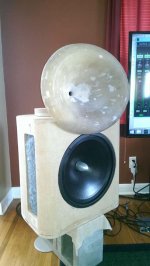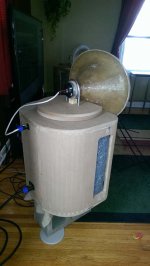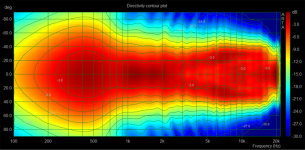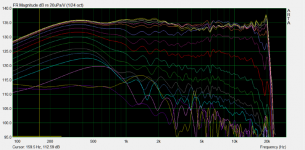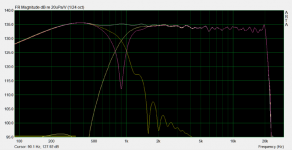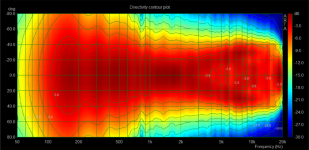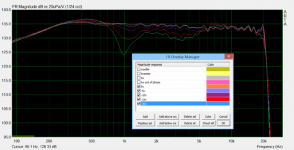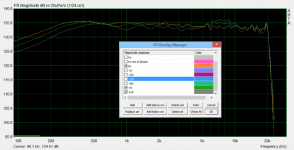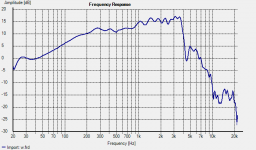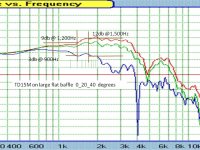So this thread will bring together a couple of project/research threads I've got going......my 15" cardioid cab: http://www.diyaudio.com/forums/multi-way/259724-dsp-midrange-directivity-control-aka-kinda-cardioid.html and my 18" wide EOS waveguide: http://www.diyaudio.com/forums/multi-way/258674-diy-18-elliptical-waveguide.html.
The idea here is to get narrower directivity well down into the midrange without resorting to a 4' horn (not that I have anything against big horns!), without giving up too much sensitivity or going dipole. I've had dipoles before but I don't want to deal with the back wave.
The idea with the cardioid cab is to have cardioid directivity around 300hz, which is about 120°, then transition to the 15" driver narrowing to 90° around 900hz. This didn't quite work how I would have liked as it maintains around 100° to just over 1khz, but it's not too bad.
The driver is a AE TD15M. These cabs exhibit a -6dB/octave roll-off at 300hz typical of a dipole, so the M wouldn't be my first choice for this app due to its' limited excursion but it's what I've got. In actual use in room I need a +6dB shelf at 200hz for flat response. I can live with that. My 3 cu ft sealed cabs for the M needed a +4dB shelf. During testing of the cardioid cab the TDs were obviously moving quite a bit at fairly low levels with no hp filter. With a LR4 at 80hz they don't appear to be working much more than they do in a sealed cab.....real scientific I know! The cabs are 21.5" wide x 22" tall x 18" deep. They have a 3" radius baffle roundover and about a 12" radius on the back corners. I used a 4" wide x 16" tall vent on each side of the cab to get the cardioid response, with the vent beginning where the baffle roundover meets the side of the cab. The cabs are lined with about 4" of somewhat compressed recycled denim insulation.
The waveguides were a serious project since this is the first time I've really worked with fiberglass and making molds. They are an approximate OS profile that I modeled in SolidWorks with an elliptical mouth. I wanted to use an ellipse to reduce ctc and to eliminate or at least mitigate the axial dip seen in a round wg without giving up too much height vertically. Physically they're 90x65, with a 1.625" mouth round-over that rolls back. The mouth is about 18" across at the deepest point in relation to the throat, and they're 14" tall. I'm using BMS 4552nd 1" exit cds.........because that's what I have. They work well, but I removed the bug screens some time ago and with all the "tinkering" that I do I think I have a problem with the diaphragm in one. There's a certain "hardness" to some vocals and a bit of a scratchy sound with certain music on every horn I've used. Time for a replacement!
Data incoming..........
The idea here is to get narrower directivity well down into the midrange without resorting to a 4' horn (not that I have anything against big horns!), without giving up too much sensitivity or going dipole. I've had dipoles before but I don't want to deal with the back wave.
The idea with the cardioid cab is to have cardioid directivity around 300hz, which is about 120°, then transition to the 15" driver narrowing to 90° around 900hz. This didn't quite work how I would have liked as it maintains around 100° to just over 1khz, but it's not too bad.
The driver is a AE TD15M. These cabs exhibit a -6dB/octave roll-off at 300hz typical of a dipole, so the M wouldn't be my first choice for this app due to its' limited excursion but it's what I've got. In actual use in room I need a +6dB shelf at 200hz for flat response. I can live with that. My 3 cu ft sealed cabs for the M needed a +4dB shelf. During testing of the cardioid cab the TDs were obviously moving quite a bit at fairly low levels with no hp filter. With a LR4 at 80hz they don't appear to be working much more than they do in a sealed cab.....real scientific I know! The cabs are 21.5" wide x 22" tall x 18" deep. They have a 3" radius baffle roundover and about a 12" radius on the back corners. I used a 4" wide x 16" tall vent on each side of the cab to get the cardioid response, with the vent beginning where the baffle roundover meets the side of the cab. The cabs are lined with about 4" of somewhat compressed recycled denim insulation.
The waveguides were a serious project since this is the first time I've really worked with fiberglass and making molds. They are an approximate OS profile that I modeled in SolidWorks with an elliptical mouth. I wanted to use an ellipse to reduce ctc and to eliminate or at least mitigate the axial dip seen in a round wg without giving up too much height vertically. Physically they're 90x65, with a 1.625" mouth round-over that rolls back. The mouth is about 18" across at the deepest point in relation to the throat, and they're 14" tall. I'm using BMS 4552nd 1" exit cds.........because that's what I have. They work well, but I removed the bug screens some time ago and with all the "tinkering" that I do I think I have a problem with the diaphragm in one. There's a certain "hardness" to some vocals and a bit of a scratchy sound with certain music on every horn I've used. Time for a replacement!
Data incoming..........
Attachments
The xo/eq is all handled with software DSP. Due to the somewhat wider directivity than I was looking for in the woofer, and narrower than I wanted on the low end of the waveguide I ended up with a LR8 acoustic crossover at 870hz. I went through several crossovers before I ended up at what I've got. My first thought was to use 6th order (that's worked well for me with waveguides before) but the blend off axis wasn't as smooth as I'd like. I also tried 4th order on the woofer and 6th on the tweeter with a bit of overlap but that wasn't any better. I tried crossing anywhere from 800-1khz and this was the best result as far as off axis response goes.
Eq'd flat on the listening axis of 15° with bit of down slope at hf. The directivity of the wg could be better but not bad for a beginner . I'm not quite sure why it narrows so much at 1khz-2khz. Narrowing before it loses control due to the small radius edge termination? The wg actually starts curving slightly out as it approaches the mouth radius in the horizontal plane. I think the elliptical shape may be contributing to the narrowing. Any ideas here?
. I'm not quite sure why it narrows so much at 1khz-2khz. Narrowing before it loses control due to the small radius edge termination? The wg actually starts curving slightly out as it approaches the mouth radius in the horizontal plane. I think the elliptical shape may be contributing to the narrowing. Any ideas here?
In-room gated at 3ms is the best I can do unfortunately. I got some data outdoors a couple weeks ago but the wind picked up and I couldn't get it optimized as well as I would like. I'll show that data in another post.
I forgot to add a legend for the FR plot...it goes 0-5-10-15-20-30-40-50-60-70-80-90-110-130-150-180. The contour plot is not normalized with 1/12 octave resolution. The FR plots are 1/24 octave.
Eq'd flat on the listening axis of 15° with bit of down slope at hf. The directivity of the wg could be better but not bad for a beginner
In-room gated at 3ms is the best I can do unfortunately. I got some data outdoors a couple weeks ago but the wind picked up and I couldn't get it optimized as well as I would like. I'll show that data in another post.
I forgot to add a legend for the FR plot...it goes 0-5-10-15-20-30-40-50-60-70-80-90-110-130-150-180. The contour plot is not normalized with 1/12 octave resolution. The FR plots are 1/24 octave.
Attachments
Here's the vertical response above and below the design axis. I didn't go any higher than +10° above the waveguide because my mic stand wouldn't go any higher  . I'd say I've got a 20° or so listening window.
. I'd say I've got a 20° or so listening window.
Also, here's a contour plot I got of the speaker outdoors a couple weeks ago to give you a better idea of the directivity of the woofer.
Also, here's a contour plot I got of the speaker outdoors a couple weeks ago to give you a better idea of the directivity of the woofer.
Attachments
Hi,
Nice cabinet for a test mule ) Regarding "hardness" of voices.
) Regarding "hardness" of voices.
I was surprised I could hear break up in my mids around 2,5kHz despite the 4'th order X-over at 1,4kHz. Using some DSP solved the issue for me.
Your woofer breaks up at 1.6-1.7kHz and is "only" down 27db?
I'm extremely sensitive in this region between 1-2.5kHz..
Peter
Nice cabinet for a test mule
I was surprised I could hear break up in my mids around 2,5kHz despite the 4'th order X-over at 1,4kHz. Using some DSP solved the issue for me.
Your woofer breaks up at 1.6-1.7kHz and is "only" down 27db?
I'm extremely sensitive in this region between 1-2.5kHz..
Peter
These aren't test mules, it's just too cold out now to finish them properly!
What you see on the woofer at 1.6khz isn't break up, just lumpy response from the side vents not working well that high. Break up on these I believe is at 2.5khz+. The hardness I mentioned was only in the left speaker with the questionable CD but good eye.
What you see on the woofer at 1.6khz isn't break up, just lumpy response from the side vents not working well that high. Break up on these I believe is at 2.5khz+. The hardness I mentioned was only in the left speaker with the questionable CD but good eye.
I'm not quite sure why it narrows so much at 1khz-2khz. Narrowing before it loses control due to the small radius edge termination? The wg actually starts curving slightly out as it approaches the mouth radius in the horizontal plane. I think the elliptical shape may be contributing to the narrowing. Any ideas here?
I think what you may be seeing is that the narrowing at 1kHz is due to the start of the woofer starting to beam (become directional due to its large size). What can help here is to either use a lower XO frequency to match the WG's polar to the woofer's range before it starts to beam. I don't know if your WG/CD combo can run lower but if you are running DSP, it's easy enough to try something like 800Hz. Alternatively, use a smaller diameter woofer, like 8in x qnty 4 to get same Sd as 15in. The 8in cones will be able to go up higher before beaming is an issue.
There's a certain "hardness" to some vocals and a bit of a scratchy sound with certain music on every horn I've used.
The hardness may be the fact that you have a rise in response around 2kHz when off axis due to the above beaming problem. The other thing may be the sharp rise near 20kHz. I find that rolling off the highs a bit from 15kHz on up helps to tame this harshness. If you look at the impulse response, you will see a ringing at 20kHz due to that peak. This will be a metallic sounding "hardness" - or sibilance similar to metal-to-metal strikes. Do a high shelf -6dB EQ starting at 15kHz with Q of 0.5 and see if it sounds better. I don't think you will lack any "air" with that mod, and it will lose the hardness.
Very nice WG effort, btw.
Last edited:
Thanks. The narrowing to 70° at 1-2k is seen entirely in the waveguide without the woofer. I said earlier that the woofer is at about 100° until 1khz.
I'll say again that the hardness is only evident in the LEFT speaker. This is something I have noticed with several different horns now, same driver. Both waveguides here have nearly the same measured response, though a bit different off axis at 8khz+
I'll say again that the hardness is only evident in the LEFT speaker. This is something I have noticed with several different horns now, same driver. Both waveguides here have nearly the same measured response, though a bit different off axis at 8khz+
If that's TD15M, that ripple is from the driver resonances, not the cabinet. Well, either that or it's in the same place as the normal driver response starts to ripple.What you see on the woofer at 1.6khz isn't break up, just lumpy response from the side vents not working well that high. Break up on these I believe is at 2.5khz+. The hardness I mentioned was only in the left speaker with the questionable CD but good eye.
edit: Looks like this (LF not accurate, obviously). I have better measurements on another computer - this is from a set taken ages ago when I was first learning how to use impulse gating, but this one looks decent:
Attachments
Last edited:
Dump truck - thanks. That's how my td looks on axis
I should add that there's a larger peak and dip around 1.5khz that I believe is from the cabinet (which I eqd), that's what I was referring to.
My 8 inch mids is quite well behaved until 2kHz but over that is a mess.
On Dumptruck's graph it looks like some issue starts already at 1kHz or could it be the normal rising response?
What size do you have on the vents? I will try this for upper bass and mid but likely with bigger openings to the side. I have all the drivers hanging on chains right now but I'm not too keen on dipole mid in my room.
Peter
On Dumptruck's graph it looks like some issue starts already at 1kHz or could it be the normal rising response?
What size do you have on the vents? I will try this for upper bass and mid but likely with bigger openings to the side. I have all the drivers hanging on chains right now but I'm not too keen on dipole mid in my room.
Peter
16" x 4" vents. I remember reading somewhere, might be John Kreskovsky, saying that the vents should be roughly equal to the driver sd. With two vents I'm just short of that. Placement is key as well.
Yes, but the damping will make a bigger difference than a few ±square inches, right? I do envy your measurements skills. I HAD an analog dB meter, cheap mic and plotted by hand. Now a forklift turned it to a wafer, gotta get me new stuff….
Peter
After some more listening it appears the HF harshness I was hearing is in both speakers. It's not always there , just on certain vocals. It's a bit of "edge" to some higher pitch voices of women and children....also males with a naturally gravelly voice. Time to do some investigating! I'll try some of the suggestions here.
One thought I had was maybe these cds aren't up to the task of that low of a crossover. If that was the case wouldn't it be apparent all the time and not only on certain dialog? There's a lot of music that I listened to without issue.....
One thought I had was maybe these cds aren't up to the task of that low of a crossover. If that was the case wouldn't it be apparent all the time and not only on certain dialog? There's a lot of music that I listened to without issue.....
Time to do some investigating! I'll try some of the suggestions here.
One thought I had was maybe these cds aren't up to the task of that low of a crossover. If that was the case wouldn't it be apparent all the time and not only on certain dialog? There's a lot of music that I listened to without issue.....
My experience was the same, some music was excellent, some unlistenable. Me think it depends on your mood, volume and the recording above all! I always thought it was my tweeter. Until I measured for hand and saw the rising response and break up of the mid. Erasing all DSP and measure the mid raw and then Eq it appox. flat, then adding XO solved some issues with voices. I still have problems but they are (I think) related to dipole issues and room. Also my mids dust cap has nasty resonances….
It's at least worth to try even if I'm an ignorant fool messing with things I shouldn't
Peter
Last edited:
- Status
- This old topic is closed. If you want to reopen this topic, contact a moderator using the "Report Post" button.
- Home
- Loudspeakers
- Multi-Way
- (Forward) Radiation Sickness - Big waveguide and cardioid
